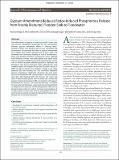| dc.contributor.author | Dharmakeerthi, Randombage S. | |
| dc.contributor.author | Kumaragamage, Darshani | |
| dc.contributor.author | Indraratne, Srimathie P. | |
| dc.contributor.author | Goltz, Doug | |
| dc.date.accessioned | 2020-11-09T21:47:44Z | |
| dc.date.available | 2020-11-09T21:47:44Z | |
| dc.date.issued | 2019-01-01 | |
| dc.identifier.citation | Dharmakeerthi, Randombage S., Darshani Kumaragamage, Srimathie P. Indraratne, and Doug Goltz. "Gypsum Amendment Reduces Redox-Induced Phosphorous Release from Freshly Manured, Flooded Soils to Floodwater." Journal of Environmental Quality 48(1) (January-February 2019): 127-135. DOI: 10.2134/jeq2018.08.0308. | en_US |
| dc.identifier.issn | 1537-2537 | |
| dc.identifier.uri | https://hdl.handle.net/10680/1853 | |
| dc.description.abstract | The effectiveness of gypsum in reducing runoff P losses from soils and the mechanisms responsible are well documented; however, gypsum amendment effects in reducing redox-induced P losses from flooded soils are less researched and documented. We examined the effect of gypsum amendment on P release from freshly manured soils to pore water and floodwater with continuous flooding for 56 d in the laboratory. Three soils (Pembina, Denham, and Dencross series) collected from Manitoba, Canada, were preincubated with liquid swine manure. Each preincubated manured soil was packed into vessels with or without recycled wallboard gypsum in triplicates and flooded for 56 d, during which pore water and floodwater were sampled weekly and analyzed for pH and dissolved reactive P (DRP), Ca, Mg, Fe, and Mn concentrations. Change in soil redox potential (Eh) with flooding was also monitored. Wallboard gypsum amendment significantly decreased the pore water and surface floodwater DRP concentrations in all three soils for most days after flooding (DAF). The Dencross soil, which had Olsen P about fivefold greater than the other soils, showed the greatest magnitude decrease in DRP concentration with gypsum amendment, by 1.27 mg L−1 on 49 DAF and 0.99 mg L−1 on 21 DAF for pore water and floodwater, respectively. Gypsum amendment (i) delayed the Eh reduction with flooding beyond +200 mV, (ii) decreased pore water pH, and (iii) increased concentrations of Ca, Mg, and Mn in pore water favoring precipitation of P, all of which may have directly or indirectly reduced the P release from flooded soils to overlying floodwater. | en_US |
| dc.description.sponsorship | Funding for this research was provided by the University of Winnipeg Major Grant and a Natural Sciences and Engineering Research Council Discovery Grant to Darshani Kumaragamage, and a fellowship awarded by the Queen Elizabeth Advanced Scholar Program to R.S. Dharmakeerthi. | en_US |
| dc.description.uri | https://acsess.onlinelibrary.wiley.com/doi/10.2134/jeq2018.08.0308 | en_US |
| dc.language.iso | en | en_US |
| dc.publisher | American Society of Agronomy, Crop Science Society of America, and Soil Science Society of America | en_US |
| dc.rights | info:eu-repo/semantics/openAccess | en_US |
| dc.subject | Phosphorus -- Environmental aspects | en_US |
| dc.title | Gypsum Amendment Reduces Redox-Induced Phosphorous Release from Freshly Manured, Flooded Soils to Floodwater | en_US |
| dc.type | Article | en_US |
| dc.rights.license | CC BY‐NC‐ND license | en_US |
| dc.identifier.doi | 10.2134/jeq2018.08.0308 | en_US |


